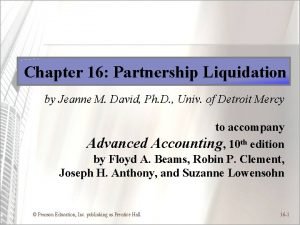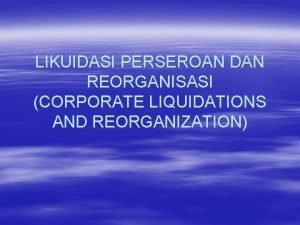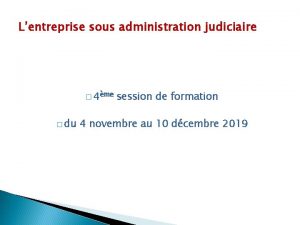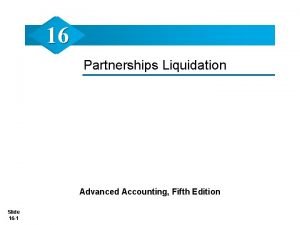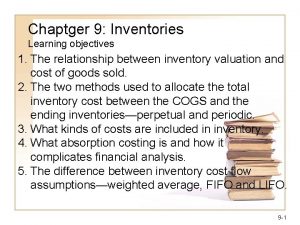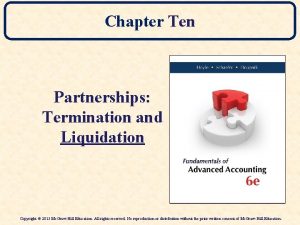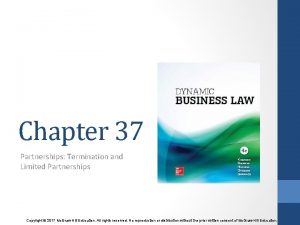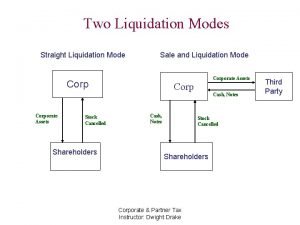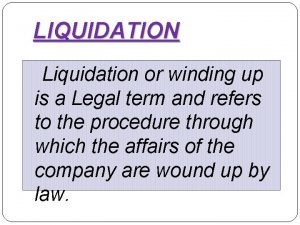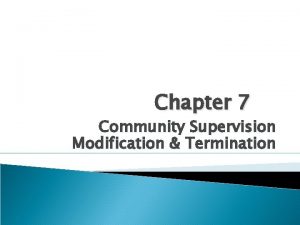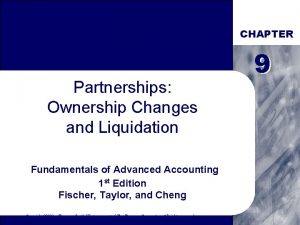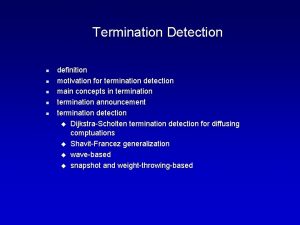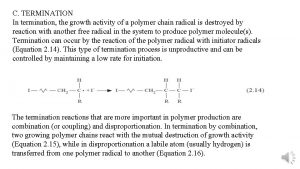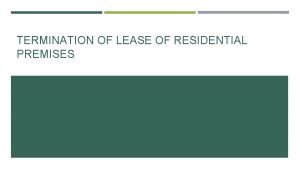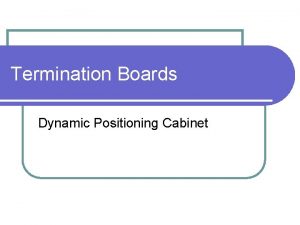Chapter Ten Partnerships Termination and Liquidation Copyright 2015















- Slides: 15

Chapter Ten Partnerships: Termination and Liquidation Copyright © 2015 Mc. Graw-Hill Education. All rights reserved. No reproduction or distribution without the prior written consent of Mc. Graw-Hill Education.

Termination and Liquidation The liquidation of a partnership generally involves three important steps: 1. Non‐cash partnership assets are sold for cash, and gains and loss on the sales are allocated to the capital accounts of individual partners on the basis of the profit and loss ratios. 2. Partnership liabilities and expenses incurred during the liquidation are paid out of the partnership’s available cash. 3. Any partnership cash remaining after paying liabilities and liquidation expenses is distributed to the individual partners on the basis of their respective capital balances. 10 -2

Termination & Liquidation The liquidation of a partnership becomes complicated if: • One or more partners have a negative (deficit) capital balance. • The liquidation takes place over an extended period of time. The accountant can facilitate distribution of cash in installments by calculating the safe payments. The accountant prepares a cash predistribution plan. 10 -3

Deficit Capital Balance Deficit balances can be resolved two ways: Ø Deficit partner can make a contribution to cover deficit. Ø Remaining partners can absorb the deficit. (Deficit partner may pay later or can be sued for the amount. ) Ø Profit / loss ratio: Holland 40%; Dozier 40%; Ross 20% Holland, Dozier, and Ross balances just prior to liquidation Cash. . $20, 000 Holland, Capital. . $ (6, 000) Dozier, Capital. . . 15, 000 Ross, Capital. . . 11, 000 Total. . . . $ 20, 000 10 -4

Deficit Capital Balance -Contribution by Deficit Partner Holland legally is required to convey an additional $6, 000 to the partnership to eliminate the deficit balance. This contribution raises the cash balance to $26, 000, which allows a complete distribution to be made to Dozier ($15, 000) and Ross ($11, 000) in line with their capital accounts. 10 -5

Deficit Capital Balance Remaining Partners Absorb Deficit If the partner resists, the loss will be written off against the capital accounts of Dozier and Ross. Allocation of Potential $6, 000 Loss Dozier. . . 2⁄3 of $(6, 000) $(4, 000) Ross. . . . 1⁄3 of $(6, 000) $(2, 000) Allocation of the loss is based on the relative profit and loss ratio specified in the articles of partnership. Dozier and Ross are credited with 40 percent and 20 percent of partnership income, respectively. The 40: 20 ratio equates to a 2: 1 relationship (or 2⁄3: 1⁄3) between the two. 10 -6

Deficit Capital Balance Remaining Partners Absorb Deficit Capital balances after distribution of Holland’s loss: Holland Dozier Ross Capital Balances $ (6, 000) $ 15, 000 $ 11, 000 Allocation of Holland’s deficit balance 6, 000 (4, 000) (2, 000) Capital Balances $ $ 11, 000 $ 9, 000 A safe payment of $11, 000 may be made to Dozier that reduces that partner’s capital account from $15, 000 to the minimum $4, 000 level. A $9, 000 payment to Ross decreases the $11, 000 capital balance to the $2, 000 limit. Thus, $11, 000 and $9, 000 are the safe payments that can be distributed to the partners without creating new deficits. 10 -7

Preliminary Distribution of Assets Under the Uniform Partnership Act, a priority ranking of creditors having claims against individual partners is recognized: Debts owed to partnership creditors. Debts owed to the other partners. Debts owed to personal creditors. 10 -8

Claims Against the Partnership Ø Individual partner’s creditors can make a claim against the assets of the partnership. Ø All partnership creditors must be satisfied. Ø The creditors can only assert claims to the extent of the specific partner’s positive capital balance. Ø Each partner is liable for ALL the debts of the partnership. Ø Partners are NEVER liable for the personal debts of the other partners. 10 -9

Predistribution Plan At the start of a liquidation, accountants produce a single predistribution plan to serve as a guide for all future payments. Whenever cash becomes available, the plan indicates the appropriate recipient(s) without drawing up everchanging proposed schedules of liquidation. The plan is developed by simulating a series of losses, each of which is just large enough to eliminate, one at a time, all of the partners’ claims to partnership property. 10 -10

Predistribution Plan Assume the following partnership is to be liquidated Assume the income sharing percentage is Rubens 50%, Smith 20%, and Trice 30%. Partnership capital reported totals $121, 000. Differing losses would reduce each partner’s current capital balance to zero. As a prerequisite to developing a predistribution plan, the sensitivity to losses exhibited by each of these capital accounts must be measured. 10 -11

Predistribution Plan First, determine the maximum loss that each partner can absorb. Divide each partner’s capital balance by their respective income sharing percent. 10 -12

Predistribution Plan Since Rubens can ONLY absorb a partnership loss of $60, 000, new balances are computed assuming that the partnership has a $60, 000 loss. With Rubens wiped out, continue calculating maximum absorbable losses using income sharing percentages of Smith, 20% (2/5) and Trice 30% (3/5). 10 -13

Predistribution Plan According to the schedule, a total loss of $115, 000 ($60, 000 from Step 1 plus $55, 000 from Step 2) leaves capital of only $6, 000, a balance attributed entirely to Smith. 10 -14

Predistribution Plan To inform all parties of the pattern by which available cash will be disbursed, the predistribution plan should be formally prepared in a schedule format prior to beginning liquidation. Liquidation expenses have been estimated. 10 -15
 Chapter 5 corporate liquidation and reorganization
Chapter 5 corporate liquidation and reorganization Statement of partnership liquidation example
Statement of partnership liquidation example Corporate liquidation and reorganization
Corporate liquidation and reorganization Accounting for partnerships chapter 12 solutions
Accounting for partnerships chapter 12 solutions Chapter 12 accounting for partnerships answers
Chapter 12 accounting for partnerships answers Copyright 2015 all rights reserved
Copyright 2015 all rights reserved Copyright © 2015 all rights reserved
Copyright © 2015 all rights reserved Entreprises en liquidation
Entreprises en liquidation Winding up vs liquidation
Winding up vs liquidation Liquidation process in accounting
Liquidation process in accounting The lifo conformity rule
The lifo conformity rule Liquidation.com
Liquidation.com Numbers ten twenty thirty
Numbers ten twenty thirty Ten ten siempre fuerzas y esperanza
Ten ten siempre fuerzas y esperanza Ten ten program
Ten ten program Accenture development partnership
Accenture development partnership

